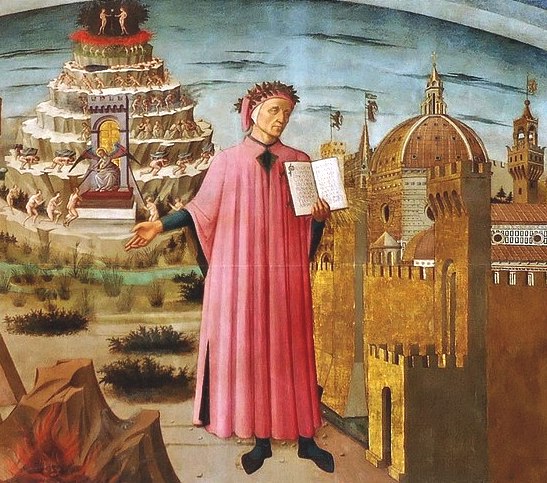
Work is underway to plan next year’s celebrations for the seven-hundredth anniversary of the death of Dante Alighieri (see previous article posted here on 22 March this year “Dante Day”). In fact Sergio Mattarella, the Italian President, went to Ravenna on 6th September to open the events (albeit behind a mask) at the recently restored tomb of the great poet, who died in Ravenna in 1321.
There is talk of a reconciliation between Florence, Dante’s birthplace, and the town of Ravenna in Romagna across the Apennines where he died in sorrowful exile. Although the Tuscan city has numerous memorials to Dante—inside and outside the church of Santa Croce, on street plaques throughout the city, a copy of his death mask in Palazzo Vecchio—there has always been a feeling that the poet’s rightful resting place should also be in Florence (the Medici pope Leo X almost succeeded in having his remains moved there). Ravenna, however, points out that it was thanks to Franciscan friars in their city that the poet’s bones were preserved at all. His tomb, right beside their convent, is a disappointment at first glance: a gloomy mausoleum erected at the end of the 18th century with further ‘embellishments’ added in the first decades of the 20th century (during celebrations for the sixth centenary of his death), but it does preserve a relief of 1483 by the great Venetian sculptor Pietro Lombardo, which shows the poet in profile surrounded by his books. Florence in fact failed to commemorate her famous son until the 19thcentury, when a cumbersome statue was set up in the centre of Piazza Santa Croce (moved to a less conspicuous position a few years later) and a rhetorical monument was erected inside the basilica. The museum known as the Casa di Dante has no original works. It is perhaps the Baptistery of Florence which stands as the most moving testimony to Dante’s presence in the city he loved and where he once acted as a Prior. He was baptised here and recalls his ‘bel San Giovanni’ in the Commedia. In 1302 he was sentenced to death in his native city, and in order to save his life he never returned there, seeking refuge instead in other places in Italy, ending up in Ravenna where he was given a home and so was able to finish the Divina Commedia.
As part of the celebrations in Florence (even today seen by some as an opportunity to ‘reconcile’ Dante with his native city) there are plans to give the Dante Museum a much-needed face-lift, and also to put on permanent display the wonderful series of frescoes of famous men (which includes Dante by Andrea del Castagno) which for many years has been hidden away in an area of the Uffizi not normally open to the public. The delightful painting in the Duomo, of Dante ‘protecting’ Florence, has been chosen as the logo of the 2021 events. There will also be all sorts of theatrical events, readings and concerts.
Dantedì (‘Dante Day’), on 25th March, is to become an annual event. One of the most interesting events scheduled for next year is the inauguration of the Museo della Lingua Italiana, a museum of the Italian language, in part of the convent of Santa Maria Novella. There will be exhibitions at the Uffizi and at the Bargello, which will include editions of his works and the most famous of the commentaries. The Accademia della Crusca in the Medici villa of Castello will publish a Dante dictionary in recognition of the fact that it was Dante who established Tuscan as the literary vernacular of Italy. In Ravenna there will also be many important exhibitions, concerts and performances. Projects are going ahead despite fears about Covid-19—of course ‘virtual’ exhibitions and events are also a possibility. One of these has already begun here, where a a panel of a hundred artists, literary figures, journalists and people from all different walks of life, have each been asked to provide a commentary on one Canto of Dante’s opus.
So the ‘bel paese’ (Dante, Inferno, canto XXXIII) is at least planning better days ahead, even linking concepts such as ‘unity’ and ‘Europe’ to its greatest poet.
by Alta Macadam







The part of the Uffizi where those frescoes of famous men have long been hidden away is the ex-church of San Pier Scheraggio. Are the plans to display them in there?
The frescoes used to be kept there but this part of the Uffizi is now linked to some Roman and medieval remains (visible beneath a glass pavement) which include the south aisle of the church. Newspaper reports have recorded the director’s plans to relocate the ‘famous men’ to another part of the Uffizi, hopefully to be opened soon. But there have also been suggestions about returning them to the room in the Villa Carducci a Legnaia for which they were painted (and where part of the cycle still remains): they were detached in the mid-19th century and stored in the Uffizi. See here for more on that story.